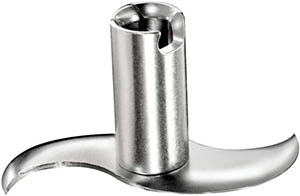-
Posts
5,172 -
Joined
-
Last visited
Content Type
Profiles
Forums
Store
Help Articles
Everything posted by paulraphael
-
It was Garland, not Viking. Bluestar's parent company (Prizer-Painter) made ranges for Garland, including Garland's consumer line. When Garland dropped out of the consumer market, Prizer kept making the ranges, and branded them Bluestar. They picked up some of Garland's design ideas, most notably the star burner, which is why Bluestar's burners are so much better than the ones on any other consumer range.
-
This is hard to answer, because it's not easy to model the heat transfer from a water bath into a liquid in a container. The speed of heating changes with the size and shape of the container and the viscosity of the liquid. No matter what, it takes a long time for the liquid to come up to temperature. This is why cooking an ice cream base sous-vide is more pretend-precise than actual precise. I still do it this for my own ice cream at home, because it works well enough, and with the batch sizes I make (in ziploc bags) the process is repeatable and gives consistent results with good control over the final temperature. But for my commercial clients I always recommend a pasteurizer, or some equivalent thing that directly heats the liquid while stirring it. If you want to try jars, it would work better with a few smaller ones than with one big one. And you might want to interrupt the process to shake or stir them a few times in the first half hour (you can use this as an opportunity to get a temperature reading and check your progress). Throwing out the ziploc bags is indeed wasteful. If I made ice cream more often I'd consider switching to a pasteurizer, or a lab hot plate with magnetic stirrer and temp probe.
-
This is a New Yorker conundrum for sure. Years ago I was neck deep in trying to make decent pizze, and then Roberta's opened up a 10 minute walk from my kitchen. End pizza experiment.
-
We're finally getting a new range, and it will be the first time I've ever had anything with a useable broiler. What do you like to broil in? I have the ugly generic enameled broiler pan that shipped with our current range (probably 40+ years ago). These just seem like messy things to clean. I assumed there would be a standard heavy wire rack that would sit in a half-sheet pan for this purpose. But when I search for things like commercial broiler rack I get nothing. There are some similar things called baking racks that double as cooling racks. Not sure what the real intent is. It seems like in restaurants they just slide a pan or sizzle platter under the salamander and call it done. Is this the best approach? If I need nothing, so much the better.
-
It used to be super illegal, but some of the laws have changed. They now make it easy for people to get microdistilling licenses, etc. ... it's why there are so many small-label bourbons and gins all of a sudden. I don't know how this affects moonshine. It might still be verboten, but maybe they care less (like the places where weed's still illegal but casual users don't get hassled anymore). BTW, I love that these beautiful things are selling at near-hillbilly prices.
-
The standard approach is to cut up the fruit and add sugar. Kind of like how you'd do a salt-rub on a piece of meat. Sprinkle generous amounts of sugar on the fruit, cover it, and let it sit in the fridge for several hours until the sugar has drawn water out of the fruit, dissolved, and been reabsorbed. It will now be resistant to turning into little rocks. And because we're less sensitive to sweetness when food is very cold, it won't taste as cloyingly sweet as you might expect. Disclaimer: I haven't done this since I worked at a commercial ice cream shop way back in the 20th century. I don't tolerate super sweet things now the way I did then. So I don't know how much I'd like this. I have not made ice cream with chunks of fruit since those days. And my ice cream consulting clients don't ask me about stuff like inclusions, so I don't know how they're handling it either. But this idea is worth trying.
- 11 replies
-
- 4
-

-

-
- Confections
- Dessert
-
(and 2 more)
Tagged with:
-
I'm guessing you'll find the best answers in farming small industrial food manufacturer forum. Most of us here have scales that go up to a few kilograms. If you learn the best way to do this, I'd love to hear it. Out of totally random curiosity.
-
If you're making uncooked bases, there probably isn't any benefit to a homogenizer. When you cook/pasteurize an ice cream base, the fat globules get more mobile and glom onto each other, making fewer bigger globules that result in a worse foam structure and texture. The homogenizing step happens right after cooking, when the fat is still hot and liquid. In order of effectiveness: doing nothing < regular blender / stick blender < high-powered blender < rotor-stator homogenizer (like Jo's) < ultrasonic homogenizer < high-pressure homogenizer (like what the dairy uses). Emulsifiers, in my experience (and depending on flavor) make a small but noticeable difference in smoothness and foam quality. Contrary to common sense, they're not used to emulsify the ice cream at all. Milk and cream are already perfectly good emulsions; the surface-active components of the milk proteins do the emulsifying, and the industrial homogenizer at the dairy makes everything stable. We actually add emulsifiers to partially destabilize the emulsion. Added emulsifiers pluck some of the milk proteins away from the fat globules, making it easier for the fat globules to partially coalesce and form a foam structure. Consider that part of the structure of ice cream is whipped cream ... we're trying to make whipped cream with a much lower fat percentage than we usually would. Anything that helps destabilize the milk and cream make this much easier. It takes very little ... there's probably enough lecithin in 1/4 egg yolk to do it for a liter of ice cream.
-
The relationship of fat to flavor really depends on the flavor. Some flavors are carried by it, others are muted by it. I don't believe any flavors benefit from a fat level above 16% or so, but some, like fat-soluble spices (vanilla) seem to do best around there. Other flavors, like fruits and coffee, are most vibrant and intense at low fat levels. I agree with you about chocolate. The main culprit is cocoa butter, which causes problems not just because of its abundance but because of its hardness at cold temperatures. The sugar and solids aren't so hard to compensate for, but the cocoa butter's always a problem. Using cocoa powder would be the solution, but chocolate companies still think of it as a byproduct. It's what's left over after extracting cocoa butter (which they use for white chocolate or to sell as an industrial ingredient) and they don't pay much attention to the powders provenance. Companies like Michel Cluizel and Valrhona do sell better cocoa powder than other companies ... but it's nothing like the quality of their own single-origin chocolates. This is not because it has to be so; they just haven't identified this as a market. Callebaut is now advertising single-origin cocoa powders to their professional customers. But I don't see a distributor in the US and they won't return my calls. Some smaller makers in the US are making fancy cocoa powder. But last I checked none had the (expensive) machine needed to mill it to a fine texture. So your ice cream would be gritty.
-

Re-filling a bottle of Poire William Eau-de-vie
paulraphael replied to a topic in Spirits & Cocktails
That would be a conundrum. There's a scene in the novel Corelli's mandolin where someone's hiding from the authorities in church balcony where a case of wine is being stored. He desperately needs to pee, and can't think of anyplace to go but one of the wine bottles. But they're all new bottles. So he uncorks one and—since he can't bear the thought of wasting the wine—drinks it before relieving himself in it. You can imagine how this ends, or doesn't. -
Someone with autocad and a machine shop could do this as a kickstarter project. I think the simplest approach would be a Vitamix attachment, since that thing is more modular. The cost of the replacement jugs for the VM would keep it from ever being really cheap, even if you could get the blades made in China.
-
I don't have one because they're huge. A vacuum machine doesn't offer enough advantages over ziploc bags for sous-vide. There are many other things chamber vac is necessary for (vacuum infusion, instant pickling, etc.) but these aren't interesting enough to me to justify the size and expense. If I move someplace with double the square feet, I'll rethink it. But my eye will probably be on more expensive ones that I can trust to not break.
-
I assume the price is high only because it's a specialized tool sold to science labs—the same reason that once upon a time you couldn't get an immersion circulator for under $1K. I'm waiting for someone to wakeup and make a rotor/stator head for a vitamix or higher-powered stick blender. How hard could it be?
-
I'm not talking about cleaning, I'm talking about getting all the food out of the thing. The vitamix is clunky at this. Which is why I almost always use it for large batches.
-
Because it's more work to scrape food out of the jug, and because it's rather heavy and doesn't live full time on our counter. Has to be pulled out and put away. Bamix is more like grabbing an electric toothbrush.
-
I found it on Amazon. $20, which seems like a lot.
-
This is something my girlfriend is using it for, and she's looking for as fast and easy a solution as possible, with minimal cleanup. We have a Vitamix but that turns everything into a bigger project. She may try pre-grinding the oats, or she may decide this is good enough.
-
Thanks for the replies everyone. I bought the sharp blade (linked above) and it does a better job than the all-purpose blade. This thing's real strength seems to be emulsions and whipping, rather than making totally smooth purees.
-
Thanks for all the ideas. I'm interested in the spun sugar/caramel idea. This is the one that occurred to me first, but I don't know if it would be hydroscopic and lose its crunch. I'm also intrigued by the bones of the dead. There may be some marzipan involved in this project. If you were to drizzle caramel that's hot enough to become brittle onto marzipan, would it melt/burn/damage it?
-
If you were making a confection, and wanted to create the sensation of crunching through little bones, what might you use? Anything that will stay nice and crisp in a moist environment? Could be a glaze or anything else. Asking for a friend.
-
We just got a Bamix Mono (the 150 watt version) after a decade or so of deliberation. I'm wondering if we got the right one. Lately my girlfriend has been using a stick blender daily for various concoctions, including one where she makes a batter out of eggs and raw oatmeal. The old cheap blender couldn't blend the oats smooth. Surprisingly, the Bamix is worse. The one we got came with 3 blades: the all-purpose 3-edged cutting blade, the emulsion maker, and the flat disk. It did not come with bigger 2-edged blade: Would this do a better job pureeing oats? Or do we need a more powerful Bamix? Or is this something the Bamix design is bad for?
-
Someone just brought this to my attention: https://diabetestalk.net/blood-sugar/what-is-atomized-glucose The same page scrapes information from my culinary site also. Probably all of the site's content is stolen. Any of the legal minds here have thoughts on this?
-
Reminds me of the Cheese Cartel propaganda they fed us as kids on Saturday mornings.
-

New Canadian Cast-Iron Manufacturer Launching Soon
paulraphael replied to a topic in Kitchen Consumer
I met a guy at a dinner party who was kick-starting a company that made artisanal cast iron pans out of recycled Kalashnikov rifles recovered from war zones. Beat that! -

Blue Star Range and Vent-a-hood? Are they really the best?
paulraphael replied to a topic in Kitchen Consumer
All of this stuff is just about odds. An appliance with a terrible repair rate might have a 25% chance of expensive failure in the first 10 years. That would still mean you've got a 75% chance of no serious trouble. And I'm not talking anyone out of buying anything. Personally, I'd love a Bluestar range. I just think it's a good idea to get all the information and do the math before committing. It also makes sense to consider who you can get to make the repairs. In a big city you've got lots of choices, but if you live farther afield, access to qualified service could be a reason to choose one brand over another.






